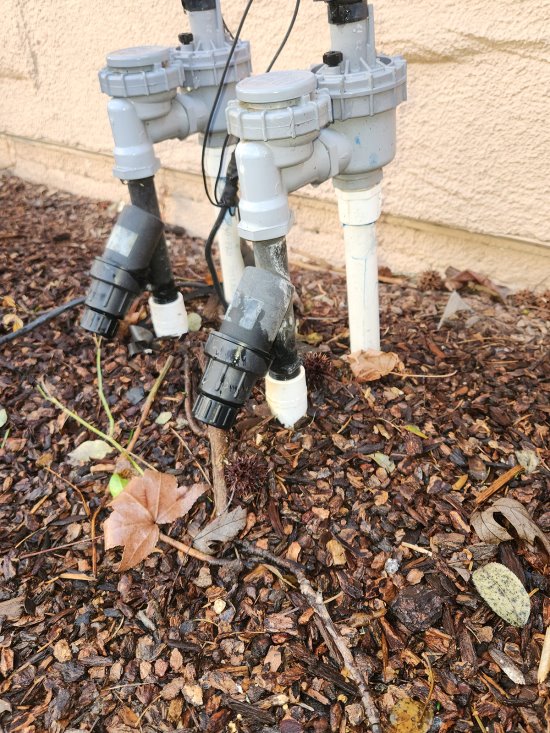
| ||||||
Water conservation is a huge issue in our area. Many people choose to conserve water by eliminating lawn areas. That's fine, but not entirely necessary. Grass lawns absorb and utilize all the water you provide. Recent studies have suggested that watering lawn areas benefits nature by replenishing the water table in the summer months. Of course, you want to water responsibly, making sure you are not sending water into the street and are only watering the grass. Modern lawn systems use pop-up spray heads that have directional spray nozzles. The pop-ups are installed to cover the configuration of the lawn using full circle, half circle, and quarter circle spray nozzles. Overhead sprayer nozzles are rated by Gallons per Minute, or "GPM." The sprayer manufacturer tells us the amount of GPM for each nozzle type. So, let's do some lawn-watering math.
Question #1: How much water does a lawn take?
Let's say a medium-sized front lawn is 45 feet long and 30 feet wide, which is 1,350 square feet. It uses six half circle heads (6-halfs times 2 GPM = 12 GPM) and two quarter circle heads (2-quarters times 1 GPM = 2 GPM) for a total of 14 gallons per minute From late spring through the summer, the system may run for 15 minutes using 210 gallons per day (14 Gal. times 15 Minutes).
Old-fashioned garden shrub areas before the 1990s typically used spray nozzles that are measured in gallons per minute and are attached to risers (tall pipes) or extra tall (12-inch) pop-up heads. In contrast to lawns which absorb and utilize the water sprayed from above, planting areas lose water to evaporation when it is sprayed over open areas of ground. Modern drip systems target water just where the plant needs it, allowing us to have beautiful landscapes AND conserve water. Explaining drip systems also requires some irrigation math; get ready for another word problem.
Question #2: How little water can I use and still have an attractive landscape?
Drip Irrigation emitters are rated by Gallons per Hour, "GPH." A rose bed which has six rose bushes with one two-GPH emitter at each bush uses 12 gallons per hour, (6 emitters times 2 GPH = 12 GPH). If that system runs for only 30 minutes (0.5 hours) per day, it uses six gallons (12 GPH times 0.5 hours = 6 gallons) of water to keep the roses beautiful. A bonus feature of using drip emitters to target water at the base of each plant is that the weeds are discouraged from growing in the dry areas in between the plants.
Replacing old-style shrub sprinklers will require some setup. The first, and most crucial, step is to install a combination filter/pressure regulator in the line just after the irrigation valve. The pressure regulator reduces the house water pressure to 30 pounds per square inch (30 PSI) to prevent blasting the lines loose from the connectors. The filter keeps minuscule bits of sediment from clogging your emitters; make sure you have one before installing your drip lines.
You may not need to run your irrigation system every day. Discuss your clock settings -- watering days, times, and duration with your gardener. Drip systems do require some maintenance, as at times the tubing connections come undone. They may get pulled loose by someone raking the yard or accidentally cut by someone digging. Don't worry, as they are easily reconnected. The soft, flexible drip lines are pushed over hard, barbed connectors. If the tubing has pulled off the connector, just snip a bit (1/2-inch) off the tip of the tube and stick it securely back on the connector. Hardware stores and nurseries sell couplers that will reconnect the tubing.
Another method of maintenance is to listen to your irrigation valves when they are running. If it sounds like a lot of water is flowing, you might have a disconnect somewhere in the line. Leave the valve on and walk around the yard looking and listening for spraying water. A wet spot on the fence or in the gutter is a dead giveaway that you have a gusher nearby. Find the problem and fix it or put a marker next to it and mention it to your landscape maintenance team the next time they visit.
Do the math! Sensible watering of your lawn, upgrading your garden sprinklers to drip irrigation, and periodically monitoring the lines as they run will conserve water and save you big bucks in the long run.
Reach the reporter at:
